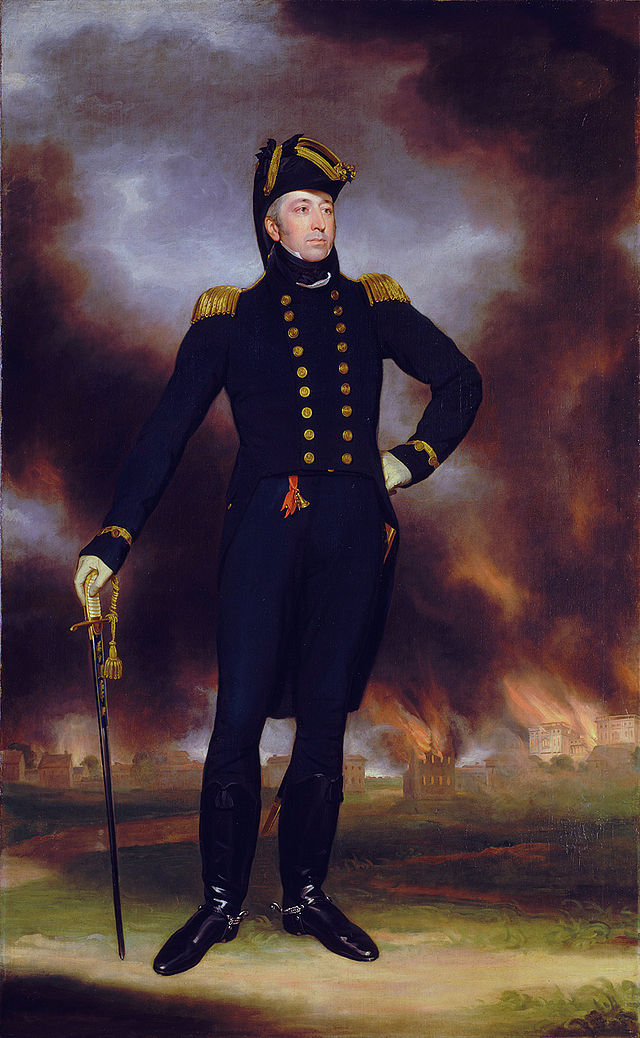It may sound like something out of the latest Hollywood disaster film, but a large portion of Washington DC was burned to the ground on 24 August 1814. The culprits? The British Empire of course.
It had been two years since the War of 1812 had begun and Britain and the USA still hadn’t resolved their issues from the American War of Independence. The British Empire focused its military might on capturing the US capital to avenge their demoralising defeat at York, Upper Canada.
Washington didn’t represent any strategic gain for the British. They just wanted to see it burned. After defeating the US Army at the Battle of Bladensburg, the British ventured into the city, intent on pillage and plunder. The Americans had already evacuated the city, so aside from a few snipers in some of the buildings on Capitol Hill, the British advance met no resistance. Their commander, General Robert Ross, held his troops back from unfocused aggression, instructing his men to concentrate on public buildings. When about 150 redcoats stormed the White House, they found that President James Madison had already fled (Madison and his wife Dolley had spied the British Army on the horizon days before) so they helped themselves to all the food and valuables in the building before setting it ablaze.

The White House was then known as the ‘Executive Mansion’ and was predominantly targeted but other landmarks on Capitol Hill such as the Library of Congress, House of Representatives and the Senate were not spared either. As well as public buildings, weapons arsenals and barracks were also destroyed. The British then marched south to burn the Washington Navy Yard, but the dock was spared by American architect Dr William Thornton, who pleaded that it be left untouched for preservation. As nightfall came, a Union Jack was raised above the city. Washington belonged to the British.
George Gleig was part of the British force that attacked and burned Washington:
“…the blazing of houses, ships, and stores, the report of exploding magazines, and the crash of falling roofs informed them, as they proceeded, of what was going forward. You can conceive nothing finer than the sight, which met them as they drew near to the town. The sky was brilliantly illuminated by the different conflagrations, and a dark red light was thrown upon the road, sufficient to permit each man to view distinctly his comrade’s face.”

Overnight, fuel was added to fires to keep them burning long into the early hours and could be seen as far away as Baltimore. The British force was not large enough to occupy the whole city, so reprieve for the Americans finally came roughly 26 hours after the British had first marched into the city. Sounding more and more like a disaster blockbuster, tornadoes and hurricanes swept through Washington, battering the British troops as its harsh winds and pouring rain, conveniently for the Americans, helped to put out the fires. Due to the adverse weather, the redcoats were forced to move on to their next target, Baltimore, as the Washington rebuilding project began. The city would not be fully repaired until 1830 and the actions of the British drew sharp criticism from across the globe. President Madison described the event as “a deliberate disregard of the principles of humanity and the rules of civilized warfare, and which must give to the existing war a character of extended devastation and barbarism.”
Instead of demoralising the Americans, the attack galvanised the nation into action and the Treaty of Ghent was signed four months afterwards, as the War of 1812 ended inconclusively.


For more on history’s most shocking conflicts, grab a copy of History of War from https://www.imagineshop.co.uk/magazines/historyofwar.html
Or subscribe now and save 30%!
References:
http://www.newworldencyclopedia.org/entry/Burning_of_Washington
http://www.history.com/this-day-in-history/british-troops-set-fire-to-the-white-house
http://www.history.com/this-day-in-history/british-capture-and-burn-washington
http://www.eyewitnesstohistory.com/washingtonsack.htm
http://www.whitehousehistory.org/history/documents/White-House-History-04-Pitch-Burning-1814.pdf
http://www.cbsnews.com/news/the-1814-burning-of-washington-d-c/
http://www.eighteentwelve.ca/?q=eng/Topic/52
http://www.american-historama.org/1801-1828-evolution/burning-of-washington.htm

